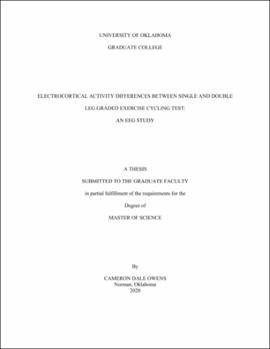| dc.description.abstract | ABSTRACT
Single leg (SL) cycling has been reported to show increases in cardiac output, neuromuscular activity, power output, and oxidative molecules when compared to double leg (DL) cycling. While these peripheral variables have been investigated, to date there is no published data regarding the response of the central nervous system (brain activity) between DL and SL cycling. Previous research has conducted electroencephalography (EEG) measures during DL cycling in a variety of protocols. More research needs to be conducted to elucidate how the brain responds to a graded exercise test (GXT). With the previous SL vs. DL peripheral data (during cycling), understanding the CNS response during a GXT and at max exercise is a step toward understanding if peripheral adaptations are centrally mediated in SL cycling. In addition, it could be a way to separate out the occurrence of central vs. peripheral fatigue. Purpose: The purpose of this study was to examine different conditions (SL cycling and DL cycling) and assess EEG activity in the whole brain and motor cortex before, during and after GXT during SL and DL cycling. Methods: 26 subjects were recruited to participate in this study. After inclusion criteria was met, and preprocessing and processing of data was complete, 8 subject’s data remained usable for analysis. All subjects completed two GXT’s, one SL and one DL. During SL testing, the workload started at 0.5W/kg body weight (BW) and increased 0.25W/kgBW every minute until volitional fatigue. DL testing workload started at 1W/kgBW and increased 0.5W/kgBW every minute until volitional fatigue. Results: Pre (R1) to post exercise (R2) in whole brain showed significant increases for DL cycling in theta () (p = 0.035), alpha () (p = 0.012), beta () (p = 0.0006), and gamma () (p = 0.013) and during SL cycling in (p = 0.023), (p = 0.049). Large effect sizes (ES) for whole brain analysis were seen in (d = 0.96, SL vs. DL = 0.00 ± 0.02 vs. 0.02 ± 0.02, p= 0.15), and (d=1.28, SL vs. DL= 0.02 ± 0.01 vs. 0.03 ± 0.02 p=0.09). Significant increases for DL and SL cycling from R1 to stage 1 (S1) were seen in DL theta () (p= 0.025) and SL theta () (p= 0.047). DL cycling elicited significant increases in right motor cortex (C4) activity from R1-R2 in (p= 0.021), (p= 0.019). Notable ES were seen between SL and DL from R1-R2 in C4: (d= 0.7, SL vs. DL= 0.01 ± 0.06 vs. 0.06 ± 0.07, p= 0.24) and (d=0.66, SL vs. DL= 0.01 ± 0.01 vs. 0.02 ± 0.01, p=0.16). Significant increases for DL cycling from R1-S1 in C4 were seen in (p= 0.03). A medium ES in C4 was found between SL and DL from R1-S1 in (d=0.61, SL vs. DL= 0.10 ± 0.14 vs. 0.17 ± 0.10, p=0.27). Conclusion: Our results are consistent with previous literature indicating elevated power values at rest. Gamma and beta increases in DL compared to SL whole brain analysis indicated by a large ES is expected due to beta and gammas proposed role of increased cortical activity. Theta activity was the only significant increase in both groups in whole brain from R1-S1. These results are consistent with previous work and allows us to infer theta’s possible role in initiating motor movement. We did see greater neural activity in C4 during DL rather than SL cycling. This allows us to infer that non-CNS mechanisms that have been previously reported are possibly activating the muscles during SL cycling to a greater extent, regardless of decreased C4 activity. Our results indicate that DL possibly has greater activation in the right motor cortex compared to SL cycling. Future research should assess DL vs SL with a larger sample size during recumbent maximal cycling to explore the activation of the peripheral and central nervous system. This could allow for clarity of the central and peripheral fatigue phenomena. | en_US |
